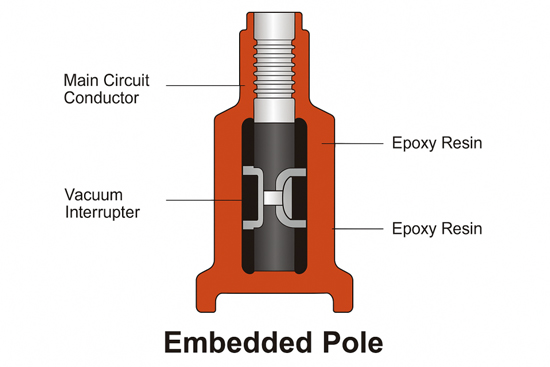In medium-voltage switchgear, especially in vacuum circuit breakers (VCBs), embedded poles have become the standard for enhancing insulation reliability, reducing maintenance, and simplifying overall structure.
An embedded pole integrates the vacuum interrupter and main circuit conductor into a solid insulating medium—typically epoxy resin—providing both mechanical support and electrical insulation in a single molded component.

Compared to traditional open-type designs, embedded poles offer clear advantages in operational stability, space efficiency, and dielectric performance. They help prevent flashovers, moisture ingress, and contamination-making them ideal for 12kV and 24kV indoor VCBs used in utility, industrial, and infrastructure projects.
Among all specifications, the 12kV embedded pole is the most widely used model, commonly found in:
·ZN63A(VS1) series vacuum circuit breakers
·Mid-voltage switchgear like KYN28 and XGN series
·Power distribution cabinets for substations and industrial plants
This standard type features:
Epoxy resin vacuum casting with embedded shielding
·Rated voltage: 12kV
·Rated current: 630A, 1250A, up to 2500A
·Compact size for easy integration into modular breakers
·Long service life with no exposed insulation points
✅ Improved Insulation Reliability
The solid encapsulation eliminates air gaps and reduces surface tracking risks under humidity or dust.
✅ Better Withstand of Mechanical Stress
Embedded structure provides strong mechanical bonding and withstands operating vibrations and heat cycles.
✅ Simplified Breaker Assembly
Factory-embedded structure reduces field assembly errors and ensures consistent performance.
✅ Long-Term Stability with No Maintenance
Once molded, the embedded pole requires no periodic inspection or re-tightening-ideal for unmanned substations.
In municipal smart grid upgrades, a utility company replaced traditional VCBs with ZN63A(VS1) circuit breakers using 12kV embedded poles. After 5 years of operation, maintenance reports show zero insulation failure events, and overall installation time was reduced by over 20% compared to older models.
·Confirm VCB model and rated parameters
·Check insulation creepage and withstand voltage specs
·Ensure compliance with IEC/GB standards
·Prefer embedded poles from experienced molders with proven epoxy formulas